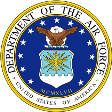Air Force updates ISR airborne sensors RFI
 On February 19, the U.S. Air Force posted an updated RFI for its USAF Airborne Sensors for Intelligence, Surveillance, Reconnaissance (ISR)(ASI) Study Supporting an Analysis of Alternatives (AoA). The response date for this posting has been extended to 8 April 2016.
On February 19, the U.S. Air Force posted an updated RFI for its USAF Airborne Sensors for Intelligence, Surveillance, Reconnaissance (ISR)(ASI) Study Supporting an Analysis of Alternatives (AoA). The response date for this posting has been extended to 8 April 2016.
An Analysis of Alternatives (AoA) is being conducted by the Air Force to investigate alternatives for materiel solutions to detect mobile targets and targets obscured by natural or man-made means. The AoA will explore tradespace in performance, schedule, risk and cost across a full range of options to address validated capability requirements. Air Combat Command’s ISR Requirements Division, ACC/A589/A51X , and AFLCMC/WI N have begun a one year Joint Capabilities Integration and Development System (JCIDS) guided pre-Material Development Decision (MOD) effort developing the following AoA related products:
- Study Guide and Plan
- Concept Characterization and Technology Descriptions (CCTDs)
The focus is on airborne sensor modalities/phenomenologies including Signals Intelligence (SIGINT) and Geospatial Intelligence (GEOINT) which includes Electro/Optical (EO), Infrared (IR), Multispectral/Hyperspectral Imaging (MSl/HSI), Ground Surveillance Radar, Full Motion Video (FMV), Light Detection and Ranging (LIDAR), and on-board processing/exploitation/fusion of sensor data.
In support of the USAF AoA for Airborne Sensors for ISR (ASI), AFLCMC/WIN is requesting inputs and conducting market research to develop CCTDs from across industry, academia and government agency programs. The AoA is being conducted to investigate alternatives for materiel solutions to detect mobile targets and targets obscured by natural or man-made means from medium and high altitudes. This activity is required to develop acquisition documentation supporting the next steps in the JCIDS/DoDI 5000.02 acquisition process. ASI is a follow-on to the ACC developed and the FY15 JROC approved Challenging Targets (CT) Initial Capabilities Document (ICD). The AoA process is expected to contribute to the selection of a preferred materiel solution that satisfies the capability need documented in the approved ICD. Following the pre-AoA and Air Force approval for a MDD, plans are to develop new Airborne Capabilities Development Documents (CDD) documents in FY17 for each of the sensor phenomenologists for both medium and high altitude. Expectations are that this effort will significantly re-define both medium and high altitude ISR sensors requirements and shape Air Force efforts in the FY20-30 timeframe.
Full information is available here.
Source: FedBizOpps







